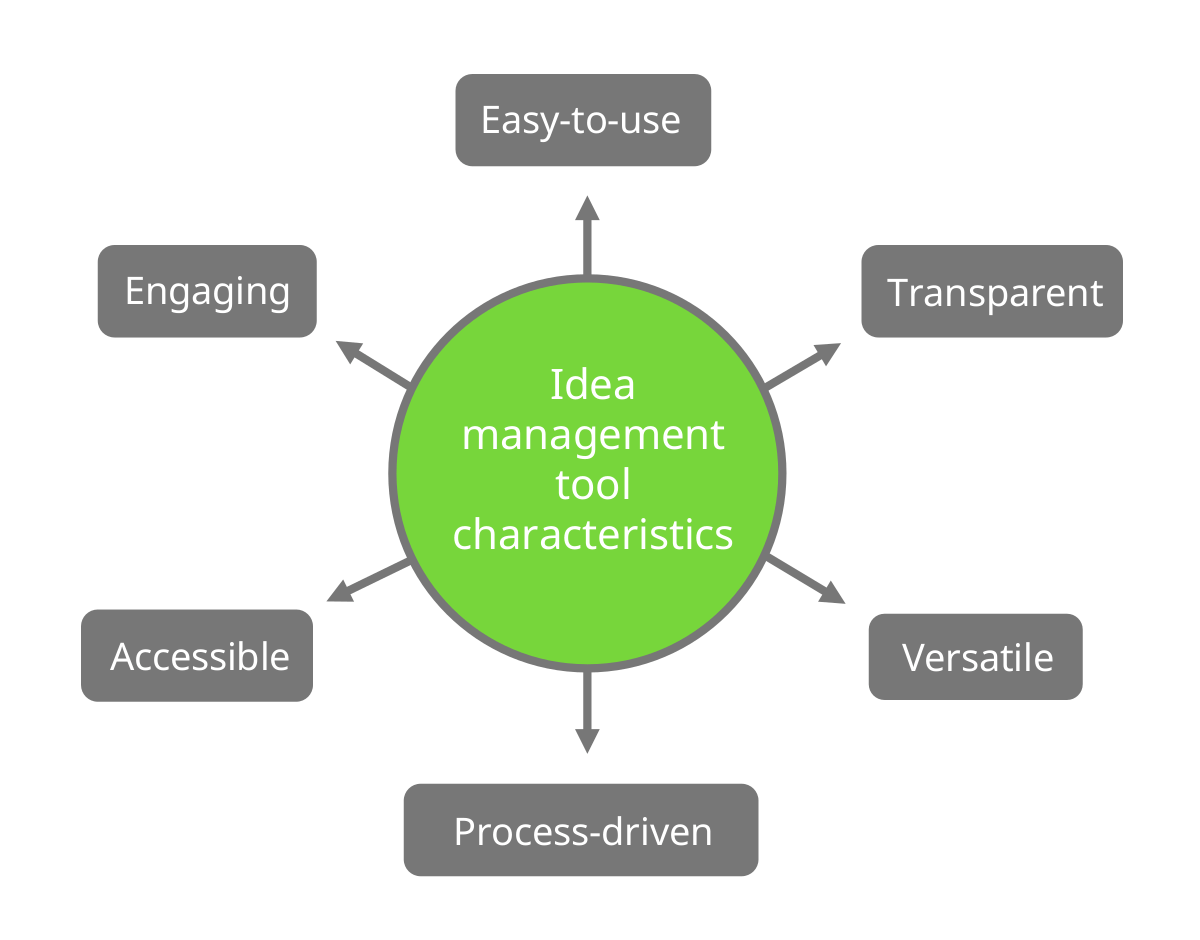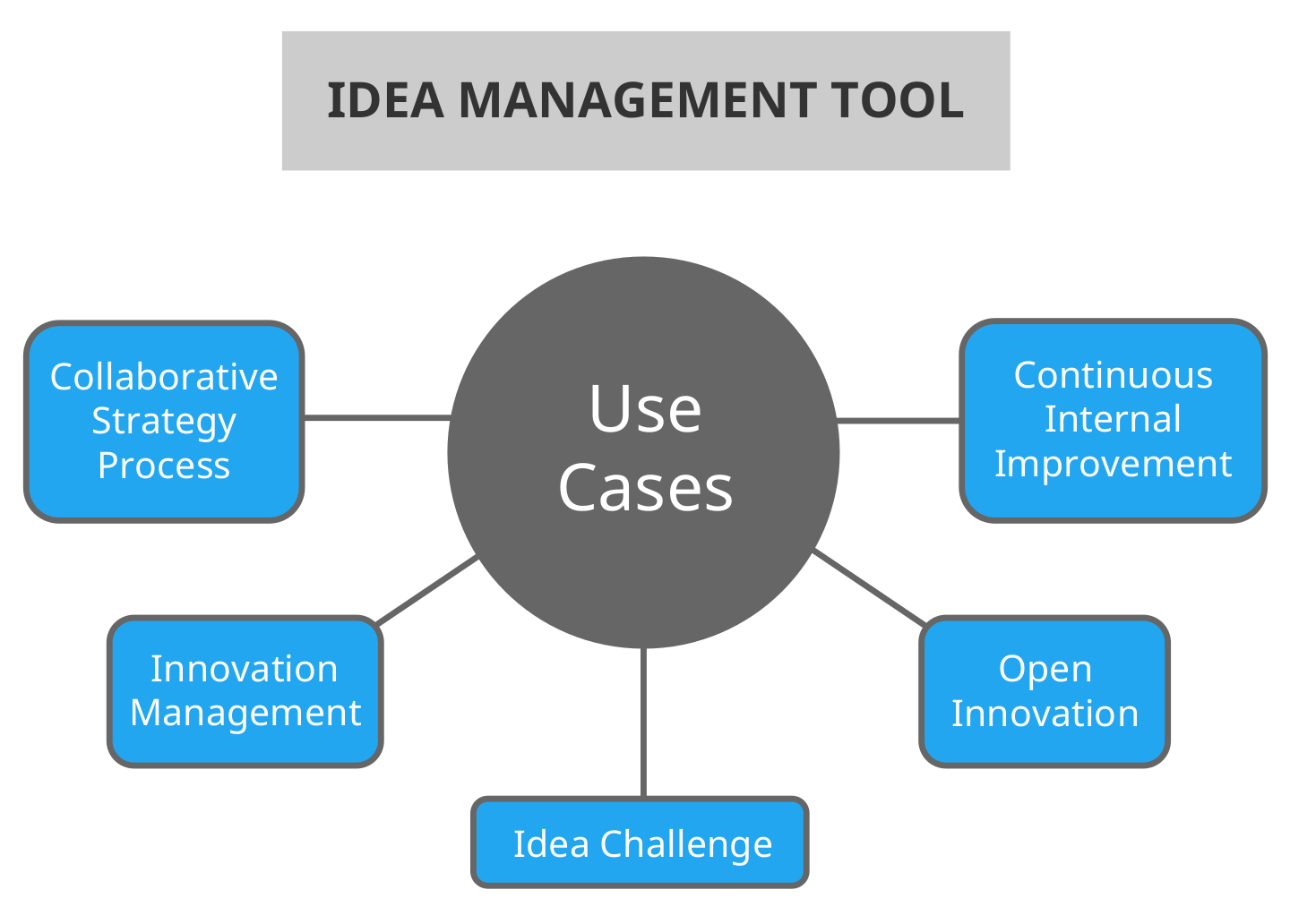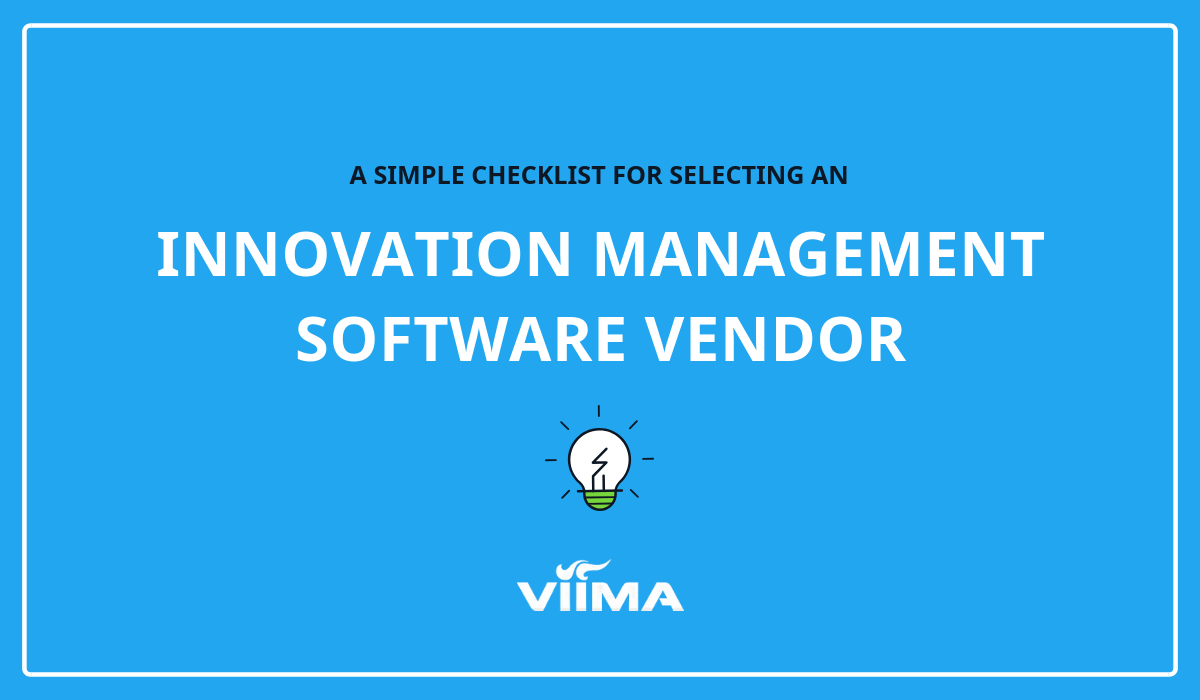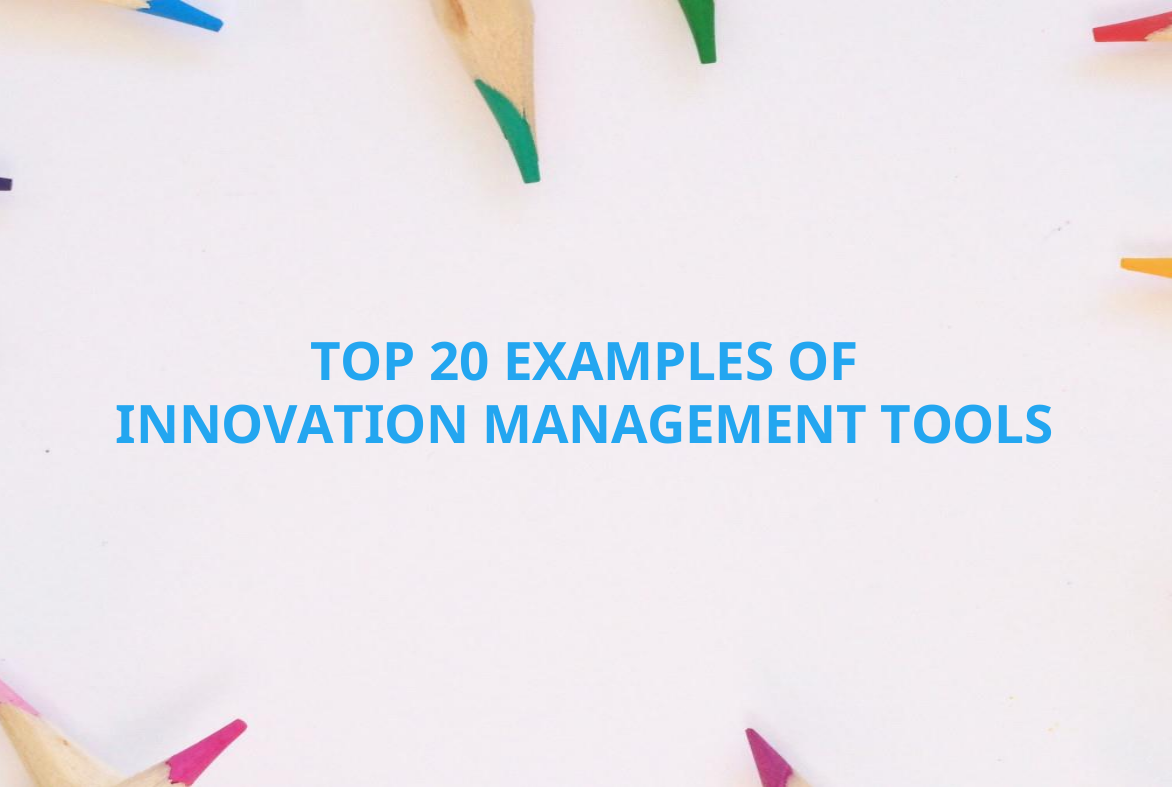What should an idea management software do? - A buyer's guide
What should you look for in an idea management software, or better yet, how do you distinguish a good software from a “bad” one, or decide which one to choose?
Idea management, by definition, means creating a systematic process for the development of ideas. For any organization that values innovation, having an effective method for realizing idea management is a necessity due to the fleeting nature of ideas.
Having innovative people who generate creative ideas is only the first kilometer in a marathon of the complex world of organizational innovation. Gathering those ideas, systematically managing and developing them into innovations are the remaining forty-one.

Table of contents
Now, due to the diversity of ideas themselves, it would be naive to say that all ideas, regardless of their type, can be managed identically. It’s important to manage different ideas through different processes to get the most out of them. At the same time, it’s usually not a good idea to have multiple solutions for different ideation purposes since it dramatically increases the likelihood of people not using any of them due to not knowing which one to use.
Therefore, it’s important that you don’t necessarily try to look for a single software to cover all of your management needs, but rather a set of tools that works seamlessly together, each serving their own role in your current (or desired) processes and ways of working.
Some of these have to be vertical solutions serving a specific need, e.g. it often makes sense for R&D and marketing departments to have their own project management systems, whereas others need to be horizontal. ERPs, intranets and idea management software are a few examples of this kind of solutions.
Being aware of this background helps you make a more informed decision on choosing the right software for your specific needs, instead of simply picking the first software that promises to make all your ideation dreams come true.
That said, there are still some notable traits that an idea management software should always facilitate regardless of your endgame.
In this guide, we will do a detailed breakdown of things that are always important in an idea management software and then go through things that can be important, depending on your goals.
Quality over quantity
Many of the software out there promise a plethora of features and results to go hand-in-hand. Don’t be misled by these notions of easy profitability or ROI when it comes to managing ideas and turning them into innovations. Successful idea management doesn’t rely on having every imaginable feature but rather the few right ones to complement your use cases. From the point of view of the end user, it can even be harmful for your endgame to have too many features if the simply confuse the users.
Therefore, especially in the early phases of choosing your software, it is paramount to rather look for the right characteristics than the most features. The difference between these two is that characteristics describe the quality of the software, whereas features simply describe the functionality.
Keep in mind, even if you have a seemingly perfect tool, it will, at best, make it easier for you to reach your goals, not get you there automatically. Do not be under the illusion that any tool will magically turn ideas into innovations. The primary focus should always be in building or improving your current processes and ways of working to support ideation. Ultimately, the best results come out of the symbiosis between a committed process and a tool that complements and further establishes said process. Thus, I truly emphasize the importance of your own input and dedication in successful idea management.
6 characteristics
You should look for well-rounded characteristics that deliver their promised functionalities as well as possible. After all, the tool that is overall more intuitive and functional in the eyes of the user, will more likely actually end up getting used. There are six vital characteristics that should be marked on the checklist of every idea management software, regardless of their promised use case. How well these characteristics are realized varies quite a lot, so we will go through each one individually to give you a better understanding of what they mean and how to distinguish a finely crafted piece of software from a hastily created one.
- Easy-to-use
- Engaging
- Transparent
- Accessible
- Versatile
- Process-driven
1. Easy-to-use
First of all, the software must be easy to use and understand, as people will simply not bother with it otherwise. Not only does this make the learning curve smoother and the software more approachable, but it increases overall retention. When it comes to a tool that is meant for everyone, regardless of technical expertise, difficulties will eliminate a sizable portion of users. Overall, this dramatically reduces the number of promising ideas being added, as well as prevents the company from molding their culture to a more engaged direction.
2. Engaging
Next, the software should be engaging in the sense that communication within the platform is made effortless and it provides the tools for facilitating engagement and encouraging conversation on the ideas. Communication is always needed to inspire and remind people to revisit the platform to contribute to ideas of interest. If there is no interaction, many ideas will just slowly dry up and fade away, even if they may have initially had great potential.

3. Transparent
Transparency goes hand-in-hand with the software being engaging in the sense that transparency begets mutual trust, which then induces openness and interaction. The more users can see ideas and comments, regardless of immediate personal relevance or expertise, the more anyone with an opinion can speak their mind.
However, this is not to say that a completely unrestricted flow of information is always optimal, and thus it should be made possible to increase or decrease the transparency of information according to its sensitivity. For example, sometimes it’s optimal to ideate with a smaller group of people, in which case it’s also important to have the possibility of limiting access to only those individuals. However, in most cases added transparency only brings more overall value to the table.
4. Accessible
Did you know that only 3% of the best ideas occur while at work? Ideas often come and go and if you don’t have the means to record them, they are easily forgotten. Considering this, limiting the accessibility of your idea management software to certain times, places or devices will certainly limit your potential benefits by a huge portion.
Thus, it’s important to provide users the possibility to record and share them whenever and wherever. What this means, in actuality, is that the software is supported by all major browsers and on all major desktop and mobile devices, and that it is not limited by location nor time.
5. Versatile
A versatile software can be easily modified to be used for different purposes. Not only is it good to have a software that works for different use cases, (as long as it doesn’t compromise intuitiveness), it’s also natural that your idea management needs evolve with time. A versatile idea management software thus supports multiple different idea management processes and also makes it easy for you to change those processes whenever you come up with ways to improve them.
In other words, a versatile piece of software can easily adapt with your changing requirements and it should be able to do that with no (or very little) configuration or further development. If your solution doesn’t have this versatility, you might be in for a very frustrating and expensive experience over the lifetime of the solution.
6. Process-driven
Managing ideas via a dedicated tool is only as effective as the underlying idea management process behind it. This is why your idea management software should be process-driven, meaning that as well as being a platform for gathering ideas, it facilitates a systematic process for developing the gathered ideas. Without an effective process that can be tuned to your specific needs, you will run into a number of difficult dilemmas such as poor communication and transfer of knowledge, ineffectiveness and biases in decision-making, as well as great ideas simply being lost in the sea of ideas.

What does your use case require?
Now that we know what characteristics to look for in general, let’s take a brief crash course on common use cases in idea management and get familiar with some of the features, which you’ll need to pay special attention to in each of these use cases. However, as we mentioned previously, none of the features really matter if the basics, i.e. the aforementioned characteristics have been taken care of.
So, without further ado, here are the most common use cases for idea management:
- Innovation management
- Continuous improvement
- Idea challenge
- Collaborative strategy process
- Open innovation
1. Innovation management
Innovation management refers to the activities, practices, processes and decisions that an organization uses to drive raw ideas all the way to concrete value generating innovations. For many organizations, this can be a highly complex and multi-dimensional set of processes across multiple teams, business units, and divisions.
The main challenge regarding innovation management is setting up continuous processes, constantly improving upon them and then sticking to the processes when they work. Some say that innovation can’t be managed, but that innovation comes from the freedom to be creative and experiment and can’t happen if there are processes in place.
While there’s excellent points there, these completely misunderstand what good processes and good management are. For example, Google’s famous 20% time is conscious management decision and there was a process in place for making that happen.
No matter how you look at it, you’re going to need processes for managing innovation and no tool in the world can autonomously take care of it entirely, but it can be of tremendous help.
Features that support innovation management:
- Process-support: As innovation management consists of many different kinds of activities and relates to many different activities of the organization, it’s inevitable that you’re going to need to support multiple different processes, for example by having separate “idea boards” for each of them
- Responsibilities: When it comes to ensuring that the organization is accountable for actually driving progress, assigning responsibilities is a crucial feature. There’s many ways to skin this cat, but nonetheless, there should be a way to make sure every idea is someone’s responsibility
- Categories: The ability to categorize ideas is crucial for makes it easier to organize your ideas of various types and for funneling them to the correct person, preferably automatically
- Evaluation: The ability to systematically evaluate ideas makes it easier to distinguish potentially valuable ideas early on and is crucial for prioritizing them
2. Continuous Improvement
Continuous improvement implies gathering improvement suggestions and best practices from employees in order to utilize them across the organization. Everyone from management to the front-line has good ideas and valuable tacit knowledge to share regarding whatever it is that they do on a daily basis. The idea is that these changes are often quite simple to implement but the effects are cumulative, leading to dramatically improved operational efficiency and/or customer satisfaction in the long run.
Much like with innovation management, the largest challenge is to build a systematic process and to stick to it. As each idea is usually a smaller, incremental suggestion, the benefits actually come from the cumulative effects of implementing dozens, hundreds or even thousands of them, which when compounded over time, really makes all the difference in the world.
As the challenges with continuous improvement are very much the same as with innovation management, the key features are also the same.

3. Idea Challenge
Idea challenge is a focused form of ideation or innovation where you gather ideas around a chose theme for a certain period of time, then refine them with the feedback of others and finally prioritize them to choose a number of ideas to be implemented. The theme of your idea challenge can either be an opportunity or a strategic focus area or an important challenge or problem that you’re looking to solve.
As idea challenges are by definition a limited-time campaign, the most important and challenging aspects are a) choosing the topic and defining the goals and b) communication. When it comes to communication, it’s equally important to be able to communicate your goals to guide ideation, as well as to simply keep everyone on the same page.
Features that support idea challenges:
- Communicating goals: You should have a possibility for clearly communicating the topic and goals of your challenge in order for people to be able to focus on the right aspects. Videos and/or images are very helpful here.
- Support for multiple challenges: The point of challenges is to focus on what’s essential. Still, most companies will benefit from almost always having at least one challenge ongoing. This means that the tool should support multiple simultaneous challenges and also make it very easy to start a new one.
- Availability of the data: As the challenge has come to an end, you usually need to move the data to somewhere else for further processing. This can be achieved with built-in integrations, open APIs, or simply by manual data exports.
4. Collaborative strategy process
Collaborative strategy process refers to engaging your organization to be a part of your strategy work, either in formulating or implementing it. Since it is the employees that make up the largest portion of the company, it is essential that their opinions are heard when it comes to defining what the organization is, what it does and why – or at the very least, how to achieve those goals. An effective and interactive channel for communication is a prerequisite of success for a collaborative strategy process.
The key challenges in collaborative strategy process are cross-departmental communication inside the organization, as well as the ability to keep the conversation focused and to-the-point.
Features that support collaborative strategy process:
- Communicating goals: Just like with idea challenges, communication is key when it comes to ensuring that people don’t lose sight of what’s important, which can easily happen when it comes to strategy
- Responsibilities: Like we mentioned earlier, when it comes to making sure that the ideas are actually implemented, assigning responsibility is crucial
- Support for facilitating conversation: When the discussion is on abstract concepts like strategy, there’s often need for facilitating the conversation and for asking the right questions, which a good software makes easy for each of the involved parties
5. Open Innovation
Open innovation is quite different from the other use cases in the sense that a company’s innovation and R&D flows are not strictly internal, as is traditionally the case. Both internal and external knowledge and expertise can be used to boost the effectiveness of a company’s innovation activities. This approach stresses the importance of relationships between the firm and its outside collaborators.
The main challenges in open innovation are reaching a relevant, yet wide enough audience and getting them interested in participating, as well as in making sure that the conversation leads into something actionable.
Features that support open innovation:
- Inviting others: As it’s crucial that you get the right participants, regardless of where they come from, it should be super easy for others to be invited and for them to join and contribute
- Support for facilitating conversation: As with collaborative strategy processes, there’s often a need to facilitate the conversation due to the different backgrounds people have, so it’s crucial to ensure that this is easy to do
- Effective communication: With open innovation, you can’t simply do a company-wide announcement to reach everyone but will need to rely more on what the tool you’ve chosen has to offer when it comes to communication

Pilot, pilot, pilot
No matter how well you do your research, that of self-inquiry in terms of your innovation goals, and the features of the perfect tool for the job, the only way to truly find out what works and what doesn’t is by trying different tools out. This can often be done without commitments through free trials or free plans, which virtually all quality vendors offer these days.
We can imagine piloting different software as going through relationships in life:
When we’re young, we have no idea what to look for in a counterpart, as everything is “tabula rasa -esque” uncharted territory. As we grow older, and we aren’t one of the few lucky ones that find their soulmate early on, we learn from relationship to relationship the traits we value and prioritize over others. Although we become pickier, we also become wiser to what elements build a lasting foundation. For most, this ultimately leads to an inseparable bond between two people.
As it is in relationships, you may get lucky and find that perfect idea management tool on your first try but it doesn’t necessarily happen that way. Learn from your experiences. By piloting various promising software, you’ll grasp new knowledge on your priorities and requirements for the software, as well as what to change in your own process (or add to it). This is a crucial part since it’s your own processes that will deliver the results, not the tool itself. Software is, in this case, just the enabler.
Through piloting, you’re more likely to ultimately find the perfect tool that nurtures your specific needs, but will also have likely gotten positive business results, even if you don’t end up continuing with the software you piloted.
Just as in a relationship, we’ll never get the full picture by just analyzing the situation, as there are always variables that we forget to consider or may not even know of. That’s why you probably want to give it a try before tying the knot.
Final thoughts
To crystallize the process of finding your perfect tool for idea management, we can boil it down to 4 simple steps:
- Chart your goals and then figure out which use cases best support these. What do you wish to achieve with an idea management software and how would it best support your existing or desired processes?
- Educate yourself on important characteristics in idea management software by using guides such as this one. Shortlist the vendors that match the selected requirements.
- Compare the vendors, both in terms of the more-difficult-to-measure characteristics, as well as the features relevant for you and your use cases and use this to eliminate vendors that are not a fit for you.
- Pilot various software that you’ve chosen through an informed elimination process and see how they work with your processes. Learn from your mistakes and successes. Repeat this step until you find a tool that works.

At Viima, we’ve heard time and again how many of our prospects have previously been disappointed in whatever system they have in place for idea management – the software failed to live up to its promise after a lengthy selection process.
That’s why we’ve made the ease of starting to use the software, as well as the time to return on investment (ROI) our top priorities, and would recommend you to look for vendors that share this mindset. If the vendor you are considering can’t provide you with the ability to pilot the software easily and free of charge, I would urge you to proceed with caution as there are likely to be unfavorable surprises in store for you.

To kick off your innovation management software vendor selection process, download this simple checklist to use as a reference. It also includes other resources that can help when choosing the right vendor.
This post is a part of our Idea Management blog-series. In this series, we dive deep into the different areas of idea management and cover the aspects we think are the most important to understand about managing ideas.
You can read the rest of the articles in our series covering idea management by clicking on the button below. Don’t forget to subscribe to our blog to receive updates of our upcoming content!







